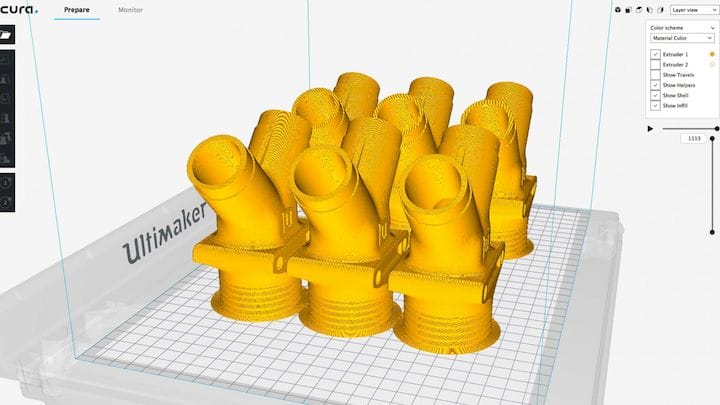![Cura 3.5 has a number of interesting improvements [Source: Ultimaker]](https://fabbaloo.com/wp-content/uploads/2020/05/image-asset_img_5eb0a5aa7a1ba.jpg)
Ultimaker has released Cura version 3.5.
The Netherlands-based 3D printer manufacturer has been supplying the open source 3D print slicing and printer management system for many years, providing periodic updates that add functionality and quality to both the software and the prints generated with it.
Now they’ve released version 3.5 and it includes a number of new features that I am quite interested in trying out.
The major feature, however, is the shift to 3MF. 3D models being worked on in Cura have always been “saved” in two ways: as an exported 3D model in a specific format, or as a project file that saves the printer and plate settings. That’s changing. Ultimaker explains what’s new:
“3MF project files. We’ve retired the ‘.curaproject’ extension. Project files now use a 3MF extension, for better compatibility between other 3D software applications.”
They’ve also clarified how this is done by changing the behavior of “Save” to mean “save the project” (in 3MF format, of course) and “Export” to mean “making a copy in a specific 3D file format”. This should make things a bit clearer to new users.
3MF, if you are not familiar, is an upcoming 3D file format that provides significantly more information than the de facto standard prehistoric .STL file format. A growing consortium of leading hardware and software companies backs the format, and it is slowly gaining acceptance among other participants in the 3D printing ecosystem.
The announcement from Ultimaker is yet another step towards universal use of 3MF.
![Cura 3.5 showing .3mf file access [Source: Ultimaker]](https://fabbaloo.com/wp-content/uploads/2020/05/image-asset_img_5eb0a5aad0bf2.jpg)
Aside from the file format changes, Cura 3.5 includes many other fixes and improvements, which are far too lengthy to list here. To see all of them, visit the Ultimaker description page at the bottom.
That said, there were several very intriguing improvements that I wish to bring forward as I believe them to be of interest.
“Improved overhang wall processing. Overhang walls are automatically detected and printed with varying speed, and perimeters will not start on an overhanging wall. Printing overhang walls at a different speed gives higher-quality and more reliable results.”
This is a problem that has plagued me from time to time, where you have a pathological overhang that slicing engines don’t understand. You can see the printer about to make a horrible mistake and think “why doesn’t it go that way!” Now, it does.
“Initial layer support line distance. This setting enables the user to reduce or increase the density of the support initial layer in order to reduce or increase adhesion to the build plate and the overall strength.”
In spite of countless ways to increase reliability of first layer adhesion, it is still a frequent problem for many users of almost all extrusion-based 3D printer equipment. Thus, anything that attempts to make it more reliable is a Good Thing in my book.
![A dramatic change in the prime pillar concept in Cura 3.5 [Source: Ultimaker]](https://fabbaloo.com/wp-content/uploads/2020/05/image-asset_img_5eb0a5ab29123.jpg)
“Prime tower reliability. Printing with two materials that don’t adhere well could cause the prime tower to fail during a print, so we have repurposed the prime tower to create a shell of one material and use it as a purge bin for a second material, giving it significantly more strength and reliability than before.”
The availability of dual extruder 3D printers has launched a kind of materials exploration event in which operators are trying many combinations. Some of these, as Ultimaker explains, don’t mix well, so they changed the prime pillar approach entirely. This is a very good thing, as the initial prime pillar concept was really for crisp changing of colors, not changing material types.
“Support infill line direction. Support infill lines can now be rotated to increase the supporting capabilities and reduce artifacts on the model. This setting rotates existing patterns, like triangle support infill.”
Strength of parts in extrusion-based 3D printers depends utterly on the direction of the extrusion, as the layer adhesion is usually the weakest part of the print. This feature suggests that one could tweak the internal direction of the support structure material and make the sometimes-spindly supports stronger.
And of course Ultimaker Cura 3.5 adds support for a number of new third party 3D printers, as it usually does in each new release. This release includes profiles for the TiZYX, Winbo, Tevo Tornado, Creality CR-10S, and Wanhao Duplicator 3D printers.
While this release is immediately usable by anyone, even those not using Ultimaker equipment, Cura is also used as base software by several other 3D printer manufacturers through customizations. As a result of the release of version 3.5, we will soon see updates to these customized versions of Cura as the changes cascade on down.
Good job, Ultimaker!
Via Ultimaker











Formlabs just issued three new videos for beginners to 3D printing, and the result was quite surprising.